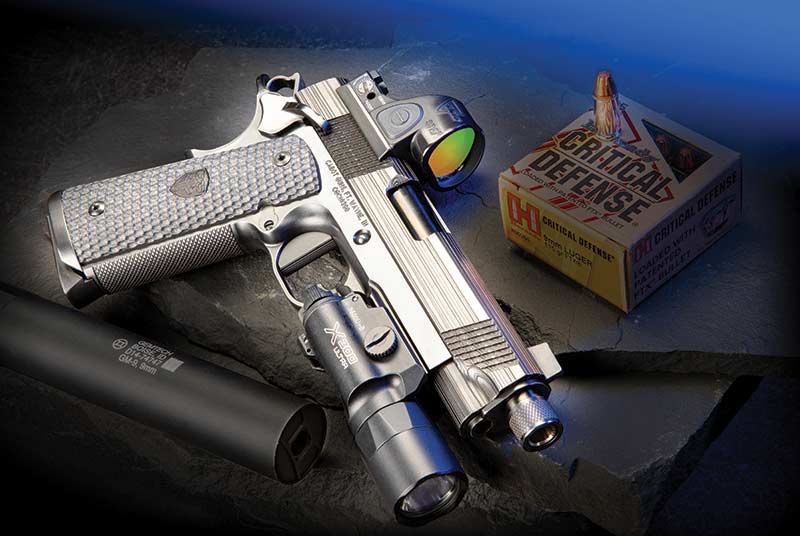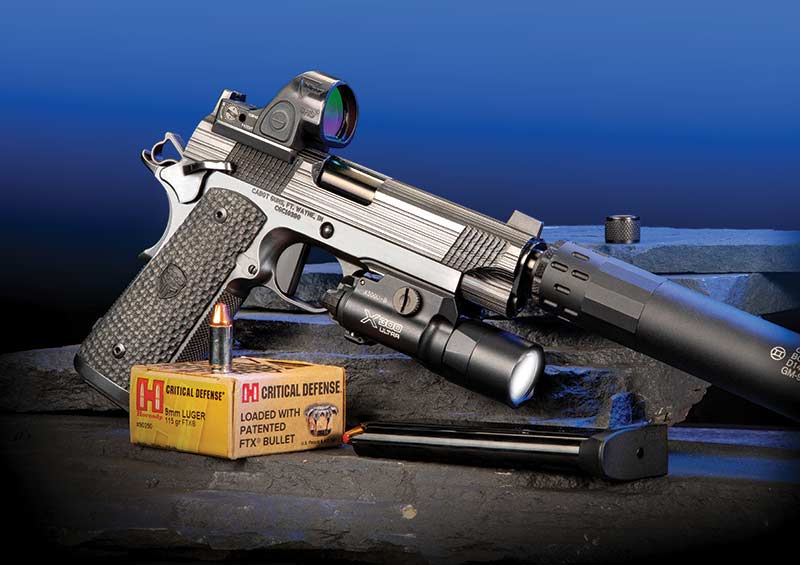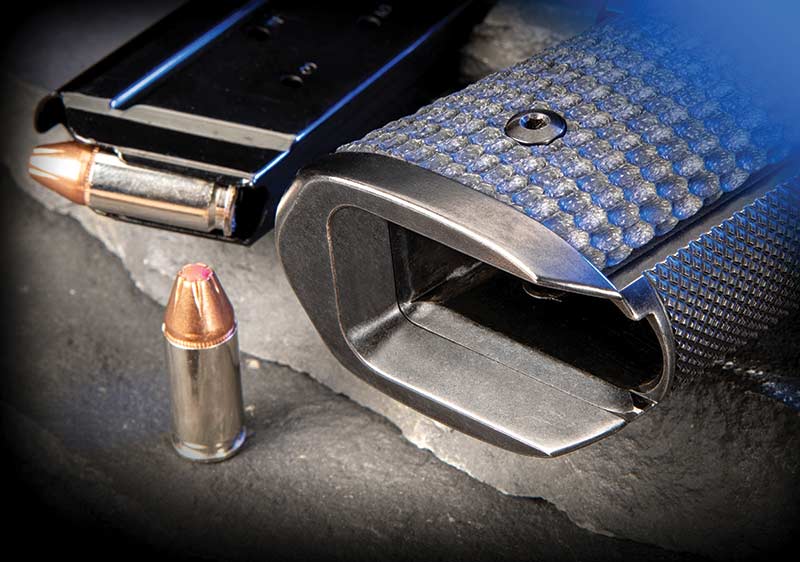Cabot Apocalypse
Beginning Where Reason Ends
Taped inside my violin case — a pastime I abandoned in my 20s, perhaps as an act of mercy towards others — is a photocopied portrait of a violinist with the caption, “Paganini begins where our reason ends.”
Written by composer Giacomo Meyerbeer, the description is apt: Niccolo Paganini, famed violin virtuoso of the 18th and early 19th centuries, was gifted with such technical prowess that even today the staccato, lightning-fast 24 Caprices he composed both stun and terrify. There is little beauty to the music — it is simply a tour de force of skill without appeal to our innate sense of beauty. This is where his story diverges from Cabot Guns, whose best work picks up where others reasonably end … but whose technical prowess has been in the service of beauty, rather than in spite of it.
Beginnings
Cabot was founded in 2011 by Rob Bianchin when he learned local high-technology manufacturer Penn United was pursuing the manufacture of 1911 components built to the same standards as the extremely precise medical and aerospace parts they were making prior to the 2008 economic slowdown. Bianchin wanted to make a gun that didn’t follow the usual standards, but rather, showcase the capability of the American craftsman working to the limits of available technology. Cabot 1911s were introduced to the public at the 2011 NRA Show in Pittsburgh, forever changing the face of the 1911.
Cabot pistols are both visually stunning and easily the most precisely made 1911 there has ever been. A bold statement, but true. Where others work in tolerances of thousandths of an inch, Cabot goes as small as millionths — a thousandth of a thousandth. To them, “American-made” does not mean imported parts of the gun are finished in the U.S.; it means they even verify the U.S. origin of the billets of steel from which the guns are machined. There is no MIM and there are no castings. While most 1911s are painstakingly hand-fitted, Cabots are truly interchangeable. This is not to disparage other pistols but what Cabot does is unique.
Their flagship pistol upon entering the market was the Jones, named after Penn United’s late founder Carl Jones. Now retired (a 2.0 is forthcoming), it featured distinctive touches like the star-pierced trigger and Trinity Stripe cocking serrations designed by architect Tom Pierce, intended as a respectful nod to the founder’s Christian faith and its doctrine of the Triune God (Father, Son and Holy Spirit). While the gun was manufactured to the strict tolerances to which Penn United was long accustomed, Bianchin recognized there were some things only a human hand can do —in this case, polish. Even the Cabot pistols which aren’t fully polished have at least 15 hours of hand finishing to remove tool marks. There is no machining process that produces such a perfect finish. Working under magnification, it takes a skilled polisher around 40 hours to produce the dripping black finish on the Jones. Sure, you can hit a slide on a buffing wheel and get a hard shine in a few minutes, but to remove all the coarser marks, to keep the flats flat, and the lines crisp and not wandering, takes time.
Certainly Not Cheap
It also costs money: The Jones debuted at an eye-watering $5,000 over a decade ago. A more affordable model would come five years later with the S-Series. It hovered in the high $3,000 range occupied by many premium 1911s. Matte instead of polished and with front strap checkering cut on the diagonal — less punishing to hands and clothes alike — the smooth grips were grooved in a distinctive arc pattern. Like the Trinity Stripes, they are more than they appear, which is a bit of a theme for Cabot. The spiraling curves follow the “Fibonacci sequence,” a mathematical ratio appearing in nature with surprising frequency.
The S-Series also brought new technology. Shortening autopistols is a dicey business, and while Commander-sized pistols — which have a 4 ¼” barrel instead of 5″ — function well with a shortened slide stroke, Cabot felt they could do better. The S103 came with a 4 ¼” barrel but retained the full slide travel of a 5″ gun, an option now available on all Cabot pistols. The system works, and it hits: My S103 put five rounds in a single hole at 7 yards. Not five holes touching to make a bigger one — no, a single half-inch hole.
The tour de force putting Cabot on most people’s radar, of course, was the Big Bang set — a pair of 1911s made from a meteorite. They’re not exactly common: Outside of the meteorite dagger found in King Tut’s tomb, there aren’t a whole lot of weapons out there made of space rocks.
Getting a big enough chunk of a meteorite is a challenge. Since they ain’t from around here, scarcity makes even small chunks quite expensive but it’s only the first problem. One does not simply open the McMaster-Carr catalog and flip to the meteor cutting tool section. Different materials require specific cutters, cutting speeds, feed rates, etc., characteristics well known for the various steel and aluminum alloys, but not so much for meteors. You have to figure that out by practicing on those extremely expensive fragments. Once you can mill, turn and broach the various parts (which often need to be hardened to different degrees), comes heat treating them correctly, lest you wind up creating the world’s most expensive pipe bomb.
Apparently they got it right: The guns have been shot. Like many of Cabot’s sets in the OAK series (One Of A Kind), the set includes a left hand 1911, a rare feat made possible by their modeling technology.
Nor is that the only difficult material they’ve challenged themselves with. There were earlier 1911s made by others with Damascus slides, but they were made of powdered Damasteel that gives the appearance of forged steel without the actual forging. It’s pretty, but I’ve stood in the undulating orange glow of a forge and watched a man with a hammer pound hot bars of steel until the two shall become one, and it’s not the same.
Challenges
The problem with traditionally forged Damascus — of which Cabot was the first to use in a 1911 — is the technique can allow voids and inclusions. This isn’t critical in a knife blade but can dangerously weaken pistol slides cycling at over 300 feet-per-second. Since it incorporates more than one type of steel, Damascus also complicates machining because you are working with something having the characteristics of more than one material, a process so painstaking Bianchin describes it as working with a machine full of pit vipers. This only sounds melodramatic if you’ve never seen what a mill can do to a piece of metal (or person) it decides it doesn’t like.
Nonetheless, Cabot found a way. By partnering with artisanal metalworkers who not only made steel homogenous enough to machine into gun parts, but could do intricate patterns well beyond the monochromatic, wood-grain look of most Damascus. Unique finishing and heat treatment brought new colors as well, brilliant blues and purples looking more like mokume, a technique similar to Damascus but using precious metals. And it’s not just slides: Customers can spec out a gun with a Damascus slide, slide and frame, or slide, frame and small parts.
If you’re thinking to yourself this must all be terribly expensive, you’re right. Producing each Cabot requires an average of $160 just in electricity to power the machines, not to mention the endless experimentation and development. Bianchin candidly admits they have lost money on “many, many” projects due to various technical challenges and the insistence on getting the end result right.
Several of these experiments converged in the Rebellion, a lightweight 9mm EDC pistol that explored possible improvements to the basic 1911 system — including a barrel with no locking lugs, scalloped slide rails to reduce friction and provide an offramp for any debris entering the slide/frame interface, and a pivoting extractor now being incorporated across the Cabot line.
Whip It Out
The standard extractor is a known weak point in the 1911. It’s essentially a bent piece of steel relying on the temper, curvature, thickness, material, etc., to provide tension on the case head during cycling. While many attempts have been made to improve on it, such as the now-defunct Para Ordnance PXT Power Extractor and a number of coil-spring-powered side extractors, the 1911 has not responded to those changes as well as the Hi-Power. It likewise started life with a straight extractor before being changed to a side version. The Cabot system, however, uses an internal pivoting extractor whose pivot point is further back, more closely approximating the travel of the original design.
The most recent representative expression of these innovations is the Apocalypse, our cover gun. High end but hard use, in your choice of 9mm or .45, the grey finish and deeply etched Damascus slide give it a worn, industrial look — the sort of thing Neo from The Matrix might have on the nightstand when he’s back home at his apartment in Zion.
Much has changed since Cabot displayed those pricey black guns in Pittsburgh in 2011. The philosophy of exceptionalism remains and Cabot has reignited the Alchemy Arms shop for those who prefer more-traditional hand-fitted 1911s.
Any number of celebrities from the entertainment industry have been photographed with Cabots, from actors and MMA fighters to musicians like Kid Rock. Price notwithstanding, there’s even a Cabot Of The Month club, a membership to which we should all aspire.
Normally, this is where I would hint toward what we can expect from Cabot in the future — but there’s no way of knowing. The sky is literally not the limit.
MSRP: $7,995 for the Apocalypse
CabotGuns.com










